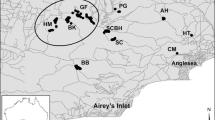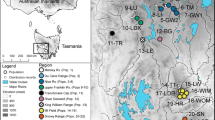Abstract
The genus Erica represents the epitome of plant biodiversity in the South African Cape fynbos with over 700 species. This genus is composed of seeder and resprouter species, but both species diversity and endemism are strongly linked to the seeder habit and concentrated in the southwestern Cape Floristic Region (CFR). Erica coccinea is a relatively abundant and widespread fynbos species whose most remarkable morphological feature is the existence of distinct seeder and resprouter forms, frequently—but not always—in disjunct populations. Both higher within-population genetic diversity and among-population differentiation have been found in seeders, most likely as a consequence of the shorter generation times and faster population turnovers. Resprouters, despite being less diverse, are suspected to be ancestral. However, no solid evidence has yet been provided for the ancestrality of the resprouter form, or for the demographic processes that have determined the current distribution of genetic diversity in both regeneration forms. Here, we used microsatellites and sequences of the nuclear ribosomal internal transcribed spacers to describe the phylogeographic structure of seeder and resprouter E. c occinea populations and provide good evidence for the ancestral status of the resprouter form and the comparatively high rates of molecular evolution in derived seeder populations. We also reveal that mixed populations, where both seeder and resprouter individuals co-occur, were originated by secondary contacts. This study highlights the role of fire in driving accelerated diversification in seeder lineages of highly speciose CFR fynbos taxa.




Similar content being viewed by others
References
Aguilar JF, Nieto Feliner G (2003) Additive polymorphisms and reticulation in an ITS phylogeny of thrifts (Armeria, Plumbaginaceae). Mol Phylogenet Evol 28:430–447
Álvarez I, Wendel JF (2003) Ribosomal ITS sequences and plant phylogenetic inference. Mol Phylogenet Evol 29:417–434
Avise JC (2000) Phylogeography: the history and formation of species. Harvard University Press, Cambridge
Bandelt H, Forster P, Röhl A (1999) Median-joining networks for inferring intraspecific phylogenies. Mol Biol Evol 16:37–48
Barraclough TG (2006) What can phylogenetics tell us about speciation in the Cape flora? Divers Distrib 12:21–26
Bell TL, Ojeda F (1999) Underground starch storage in Erica species of the Cape Floristic Region—differences between nonsprouters and resprouters. New Phytol 144:143–152
Blanco-Pastor JL, Vargas P, Pfeil BE (2012) Coalescent simulations reveal hybridization and incomplete lineage sorting in Mediterranean Linaria. PLoS One 7(6):e39089
Born C, Hardy OJ, Chevallier MH, Ossari S, Attéké C, Wickings EJ, Hossaert-Mckey M (2008) Small-scale spatial genetic structure in the Central African rainforest tree species Aucoumea klaineana: a stepwise approach to infer the impact of limited gene dispersal, population history and habitat fragmentation. Mol Ecol 17:2041–2050
Bouillé M, Bousquet J (2005) Trans-species shared polymorphisms at orthologous nuclear gene loci among distant species in the conifer Picea (Pinaceae): implications for the long-term maintenance of genetic diversity in trees. Am J Bot 92:63–73
Bytebier B, Antonelli A, Bellstedt DU, Linder HP (2011) Estimating the age of fire in the Cape flora of South Africa from an orchid phylogeny. Proc R Soc Lond Biol 278:188–195
Campbell BM (1986) Montane plant communities of the Fynbos Biome. Vegetatio 66:3–16
Cornuet JM, Santos F, Beaumont MA, Robert CP, Marin JM, Balding DJ et al (2008) Inferring population history with DIYABC: a user-friendly approach to approximate Bayesian computation. Bioinformatics 24:2713–2719
Cowling RM (1987) Fire and its role in coexistence and speciation in Gondwanan shrublands. S Afr J Sci 83:106–112
Cowling RM, Potts AJ, Bradshaw PL, Colville J, Arianoutsou M, Ferrier S, Forest F, Fyllas NM, Hopper SD, Ojeda F, Proches S, Smith RJ, Rundel PW, Vassilakis E, Zutta BR (2015) Variation in plant diversity in mediterranean-climate ecosystems: the role of climatic and topographical stability. J Biogeogr 42:552–564
Cowling RM, Proches S, Partridge TC (2009) Explaining the uniqueness of the Cape flora: incorporating geomorphic evolution as a factor explaining its diversification. Mol Phylogenet Evol 51:64–74
Dereeper A, Guignon V, Blanc G, Audic S, Buffet S, Chevenet F et al (2008) Phylogeny.fr: robust phylogenetic analysis for the non-specialist. Nucleic Acids Res 36:W465–W469
Dick CW, Heuertz M (2008) The complex biogeographic history of a widespread tropical tree species. Evolution 62:2760–2774
Ellis AG, Verboom GA, van der Niet T, Johnson SD, Linder HP (2014) Speciation and extinction in the Greater Cape Floristic Region. In: Allsopp N, Colville JF, Verboom GA (eds) Fynbos: ecology, evolution and conservation of a megadiverse region. Oxford University Press, Oxford, pp 119–141
Edgar RC (2004) MUSCLE: multiple sequence alignment with high accuracy and high throughput. Nucleic Acids Res 32:1792–1797
Goldblatt P, Manning JC (2002) Plant diversity of the Cape region of southern Africa. Ann Missouri Bot Gard 89:281–302
Hewitt GM (1996) Some genetic consequences of ice ages, and their role in divergence and speciation. Biol J Linn Soc 58:247–276
Hewitt GM (2000) The genetic legacy of the Quaternary ice ages. Nature 405:907–913
Ishida S, Taylor DJ (2007) Quaternary diversification in a sexual Holarctic zooplankter, Daphnia galeata. Mol Ecol 16:569–582
Jia DR, Liu TL, Wang LY, Zhou DW, Liu JQ (2011) Evolutionary history of an alpine shrub Hippophae tibetana (Elaeagnaceae): allopatric divergence and regional expansion. Biol J Linn Soc 102:37–50
Knowles LL (2009) Statistical phylogeography. Annu Rev Ecol Evol Syst 40:593–612
Lamont BB, Enright NJ, He T (2011) Fitness and evolution of resprouters in relation to fire. Plant Ecol 212:1945–1957
Latta RG, Mitton JB (1999) Historical separation and present gene flow through a zone of secondary contact in ponderosa pine. Evolution 53:769–776
Librado P, Rozas J (2009) DnaSP v5: a software for comprehensive analysis of DNA polymorphism data. Bioinformatics 25:1451–1452
Linder HP (2003) The radiation of the Cape flora, southern Africa. Biol Rev 78:597–638
Litsios G, Wüest RO, Kostikova A, Forest F, Lexer C, Linder HP, Pearman PB, Zimmermann NE, Salamin N (2014) Effects of a fire response trait on diversification in replicated radiations. Evolution 68:453–465
Malan MC (2013) Intraspecific variation in Erica coccinea. MSc Thesis, University of Cape Town, South Africa. https://open.uct.ac.za/handle/11427/6672
Marean CW, Cawthra HC, Cowling RM, Esler KJ, Fisher E, Milewski A, Potts AJ, Singels E, De Vynck J (2014) Stone age people in a changing South African greater Cape Floristic Region. In: Allsopp N, Colville JF, Verboom GA (eds) Ecology and evolution of fynbos: understanding megadiversity. Oxford University Press, Oxford, pp 164–199
Mcdonald DJ, Juritz JM, Cowling RM, Knottenbelt WJ (1995) Modelling the biological aspects of local endemism in South African Fynbos. Plant Syst Evol 195:137–147
Midgley GF, Reeves G, Klak C, Richardson J (2005) Late tertiary and quaternary climate change and centers of endemism in the southern African flora. In: Purvis A, Gittleman J, Brooks T (eds) Phylogeny and conservation. Cambridge University Press, Cambridge, pp 230–242
Migliore J, Baumel A, Juin M, Médail F (2012) From Mediterranean shores to central Saharan mountains: key phylogeographical insights from the genus Myrtus. J Biogeogr 39:942–956
Müller K, Albach DC (2010) Evolutionary rates in Veronica L. (Plantaginaceae): disentangling the influence of life history and breeding system. J Mol Ecol 70:44–56
Ojeda F (1998) Biogeography of seeder and resprouter Erica species in the Cape Floristic Region-where are the resprouters? Biol J Linn Soc 63:331–347
Ojeda F, Brun FG, Vergara JJ (2005) Fire, rain, and the selection of seeder and resprouter life-histories in fire-recruiting, woody plants. New Phytol 168:155–165
Oliver EGH (1991) The Ericoideae (Ericaceae)—a review. Contrib Bolus Herb 13:158–208
Oliver EGH, Oliver IM (2002) The genus Erica (Ericaceae) in southern Africa: taxonomic notes 1. Bothalia 32:37–62
Pirie MD, Oliver EGH, Bellstedt DU (2011) A densely sampled ITS phylogeny of the Cape flagship genus Erica L. suggests numerous shifts in floral macro-morphology. Mol Phylogenet Evol 61:593–601
Posada D, Crandall KA (2001) Intraspecific gene genealogies: trees grafting into networks. Trends Ecol Evol 16:37–45
Schnitzler J, Barraclough TG, Boatwright JS, Goldblatt P, Manning JC, Powell MP, Rebelo T, Savolainen V (2011) Causes of plant diversification in the Cape biodiversity hotspot of South Africa. Syst Biol 60:343–357
Segarra-Moragues JG, Ojeda F (2010) Postfire response and genetic diversity in Erica coccinea: connecting population dynamics and diversification in a biodiversity hotspot. Evolution 64:3511–3524
Shaw J, Lickey EB, Beck JT, Farmer SB, Liu W, Miller J, Siripun KC, Winder CT, Schilling EE, Small RL (2005) The tortoise and the hare II: relative utility of 21 noncoding chloroplast DNA sequences for phylogenetic analysis. Am J Bot 92:142–166
Simons AM (2002) The continuity of microevolution and macroevolution. J Evol Biol 15:688–701
Smith SA, Donoghue MJ (2008) Rates of molecular evolution are linked to life history in flowering plants. Science 322:86–89
Soria-Hernanz DF, Fiz-Palacios O, Braverman JM, Hamilton MB (2008) Reconsidering the generation time hypothesis based on nuclear ribosomal ITS sequence comparisons in annual and perennial angiosperms. BMC Evol Biol 8:344
Stephens M, Donnelly P (2003) A comparison of Bayesian methods for haplotype reconstruction from population genotype data. Am J Hum Genet 73:1162–1169
Verboom GA, Linder HP, Forest F, Hoffmann V, Bergh NG, Cowling RW (2014) Cenozoic assembly of the Greater Cape Flora. In: Allsopp N, Colville JF, Verboom GA (eds) Fynbos: ecology, evolution and conservation of a megadiverse region. Oxford University Press, Oxford, pp 93–118
Verdaguer D, Ojeda F (2002) Root starch storage and allocation patterns in seeder and resprouter seedlings of two Cape Erica (Ericaceae) species. Am J Bot 89:1189–1196
Verdaguer D, Ojeda F (2005) Evolutionary transition from resprouter to seeder life history in two Erica (Ericaceae) species: insights from seedling axillary buds. Ann Bot 95:593–599
Verdú M, Pausas JG, Segarra-Moragues JG, Ojeda F (2007) Burning phylogenies: fire, molecular evolutionary rates, and diversification. Evolution 61:2195–2204
Wells PV (1969) The relation between mode of regeneration and extent of speciation in woody genera of the California chaparral. Evolution 23:264–267
Whittle CA, Johnston MO (2003) Broad-scale analysis contradicts the theory that generation time affects molecular evolutionary rates in plants. J Mol Evol 56:223–233
Yue JX, Li J, Wang D, Araki H, Tian D, Yang S (2010) Genome-wide investigation reveals high evolutionary rates in annual model plants. BMC Plant Biol 10:242
Acknowledgments
This contribution is dedicated to the memory of Peter Clarke, whose passionate interest in the evolutionary relationships between plants and fire has been so contagious and inspiring. The manuscript benefited greatly from comments by two anonymous referees. Cape Nature and SANPARKS issued the necessary permits for fieldwork. FO strongly thanks the Spanish Ministerio de Educación (travel Grant PR2010-0365) and the UCA Plan Propio de Investigación for providing travelling bursaries to do fieldwork. KBB acknowledges a PhD scholarship (FPI, BES-2009-015443) of the Spanish Ministry of Science and Innovation (MICINN). MH acknowledges a Ramón y Cajal fellowship (RYC2009-04537) from the Spanish Ministry of Science and Education (MICINN), and funding from the Research Council of Norway (203822/E40) and the Spanish Ministry of Economy and Competitiveness (CGL2012-40129-C02-02). SCGM and MH acknowledge the support of Marie Curie Intra European Fellowships within the 7th European Community Framework Programme (FP7-PEOPLE-2012-IEF, project nos. 328146 and 329088, respectively). JGS-M acknowledges a Ramón y Cajal fellowship (RYC2009-05164) from MICINN.
Author information
Authors and Affiliations
Corresponding author
Additional information
Communicated by Prof. Michael Lawes, Prof. Ross Bradstock and Prof. David Keith.
Electronic supplementary material
Below is the link to the electronic supplementary material.
Rights and permissions
About this article
Cite this article
Ojeda, F., Budde, K.B., Heuertz, M. et al. Biogeography and evolution of seeder and resprouter forms of Erica coccinea (Ericaceae) in the fire-prone Cape fynbos . Plant Ecol 217, 751–761 (2016). https://doi.org/10.1007/s11258-015-0539-8
Received:
Accepted:
Published:
Issue Date:
DOI: https://doi.org/10.1007/s11258-015-0539-8




